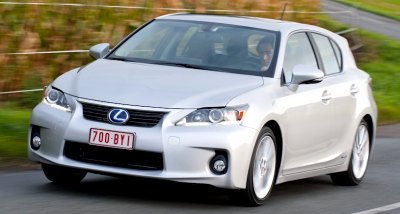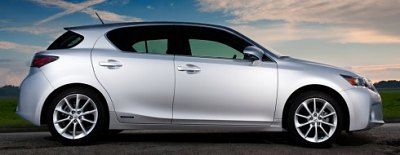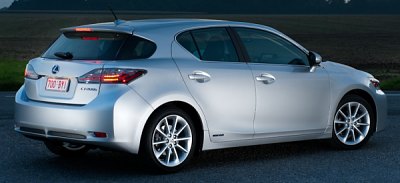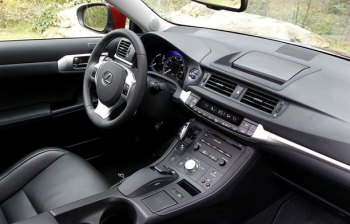Lexus CT200h
Debut: 2010 |
||||||||
In the USA, Lexus has long been the best selling luxury brand, overshadowing Mercedes, BMW and Audi. However, situation in Europe is on the contrary. Both its sales and image are running far behind its European rivals, even though it is offering much the same lineup as its rivals, i.e. IS (vs 3-series), GS (vs 5-series), LS (vs 7-series), RX (vs X5) and even the LF-A supercar (vs nothing). Nevertheless, one thing it is yet to offer is a baby premium hatchback like BMW 1-series and Audi A3. This is where its business can expand. Hatchbacks have always been big sellers in Europe, and they are getting grip in America and Asia as well, so it makes sense for Lexus to develop a baby hatchback. Another thing Lexus thought hard was how to mark its baby hatchback out of the competition. As sales is conservatively projected at 25,000-30,000 cars a year in Europe, it cannot afford to spend too much money on developing new engines and chassis technology. Therefore it decided not to compete head on with BMW 1-series and Audi A3. Instead, it is designed to be a hybrid vehicle exclusively, utilizing the hybrid technology and components of Prius to save costs while boosting its green image. Very clever.
But to execute the plan is not so amusing. In my opinion, it is virtually impossible to convert the Prius platform into a premium car that rivals BMW and Audi for performance and handling. Let's talk about performance first. The Prius' hybrid powertrain combines a 98hp 1.8-liter Atkinson-cycle gasoline engine with an electric motor to produce only 134 horsepower. That would have been fine on a conventional small hatchback, but after loading the car with Nickel-metal hydride battery, power inverter and a premium packaging necessary for this class, its kerb weight grows to 1370 kg. No one will get excited with its 112 mph top speed or 10-second 0-60 mph acceleration. Admittedly, the extra low-down torque of electric motor makes life easier than the figures suggested, but the CT200h is still far from quick, let alone fun. You may get extra electrical shove than in the case of Prius once switch to Sport mode. Even so, it does not feel particularly energetic, much less so than a diesel 1-series or TFSI A3. The long-stroke engine is unwilling to rev beyond 6000 rpm. The planetary CVT tends to ignore your throttle command and keep the rev constant. The disconnection between your right foot and speed or noise is an unpleasant experience to keen drivers. It might be okay to the drivers of Prius, but unlikely to please target customers of this class. It is hard to see how the CT could steal sales from BMW and Audi.
The rest of the driving experience is similar. Of course, you may say the CT handles its body motion far better than Prius. It manages that because it has a 100mm shorter wheelbase, which should result in enhanced agility and chassis rigidity. Its monocoque is further stiffened with tricky tower braces (which incorporate dampers to achieve structural reinforcement without generating unwanted NVH). To enhance grip, it sacrifices some of the fuel economy for a set of 215/45VR17 tires. Moreover, instead of the Prius' torsion-beam rear suspension, it employs the same double-wishbone setup as Avensis and HS250h (both are built on the same platform as Prius and Corolla). As a result, the CT corners and rides pretty well. Nevertheless, pretty well is not good enough to compete with its European counterparts. Compare with them, the CT's handling is less agile. It runs into understeer easier and its stability control intervenes too early, ruining the chance of exploiting its chassis. Worst of all, its controls are wooden. It has all the typical flaws of hybrid cars, namely, lack of correlation between throttle and engine response, abrupt brake feel (soft initial bite as regenerative braking is engaged) and a lifeless electrical steering. Switch to Sport mode, the steering gains weight but not any more feel. Although Toyota is leading hybrid technology, it has spent little effort to improve these driver interfaces. Look at Ford Fusion Hybrid and Chevrolet Volt, their controls are more linear and natural-feeling. The Prius component set on Lexus CT is relatively old fashioned.
The Lexus hybrid is not as clean and frugal as Prius due to its higher drag (0.29 instead of 0.25), wider tires and less aggressive regenerative braking. Still, a combined consumption of 68.9 mpg and carbon footprint of 96 grams per kilometer are remarkable. Just don't be too keen on throttle, because that will dip its mpg figure below those of its diesel opponents. The styling of this car has strong influence by BMW 1-series and its flame-surface treatment (i.e. a polite way to say it is a copycat), but in place of the double-kidney grille is an ugly nose design. More original is the iQ-style wraparound rear window, though the resultant thick C-pillars hamper rear quarter visibility. The CT's proportion pretends to be a rear-wheel drive machine, but its execution is so odd that it is hard to look beautiful from any angle. Far better is the interior, which is stylish, well built and easy to use. Very generously equipped too, if you opt for the top model. However, the CT is also more expensive than the equivalent 1-series and A3 due to its hybrid components. Its interior is no less cramped (rear seats cannot accommodate those over 5 ft 10 in). The boot is small and shallow due to the battery pack lying underneath it. Cabin refinement is good, but not up to the usual high standard of Lexus. On broken surfaces there is too much tire noise and harshness transmitted to the cabin. If you love the quality, taste and driving dynamics of European premium hatchbacks, you have better to choose BMW 1er, Audi A3 or even better, Volkswagen Golf GTI. They might be less green, but they don't have the serious compromises you will find in the baby Lexus. On the other hand, if you purely pursue green mobility, nothing would be better than a Prius. The combination of premium car quality and green mobility has nothing wrong. What goes wrong is the execution here. |
||||||||
| The above report was last updated on 26 Oct 2010. All Rights Reserved. |
| Specifications | ||||||||||||||||||||||||||||||||||||||||||||||||||
|
|
||||||||||||||||||||||||||||||||||||||||||||||||||
|
|
||||||||||||||||||||||||||||||||||||||||||||||||||
|
||||||||||||||||||||||||||||||||||||||||||||||||||
| Performance
tested by: *Autocar,
**C&D |
Copyright©
1997-2010
by Mark Wan @ AutoZine



